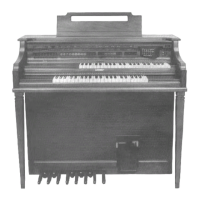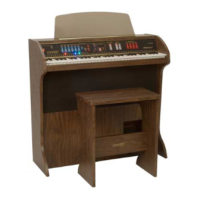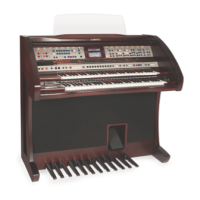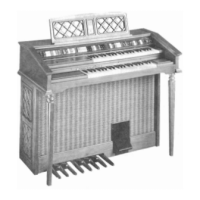Do you have a question about the Lowrey SCT and is the answer not in the manual?
Details specific voice settings for the upper keyboard.
Lists and describes various sound effects available on the organ.
Explains user-adjustable settings for sound modification.
Lists preset sustain sounds for different instrument voices.
Outlines the available percussion instrument sounds.
Describes the orchestral synthesizer voices and controls.
Details the voices available on the lower keyboard's Genie system.
Details the automatic rhythm system and its features.
Explains the Magic Genie chord system.
Lists general features of the organ.
Provides physical dimensions of the organ.
Explains the circuit for vibrato generation and tone division.
Details the integrated circuits for octave synthesis and division.
Describes DC control circuits for various keyboard effects.
Details the circuit for controlling sustain duration.
Explains the mechanism for cancelling sustain.
Describes the circuit for the slow attack effect.
Explains the circuit for driving percussion effects.
Details the circuit responsible for the wow effect.
Explains the circuit for the electric piano sound.
Explains the circuit for the tremolo effect.
Details flute filters and keying groups for the upper keyboard.
Describes the flute filter circuits.
Explains the function of FET switchers.
Details collector amplifiers for reed and string voices.
Explains flute preamplifier circuits.
Contains diagrams for flute presets and related circuits.
Describes the latching mechanism for flute presets.
Diagrams for lower keyboard flute filters, Genie modulator, and R/S collector amps.
Describes filter circuits for lower keyboard flute voices.
Details the Genie modulator and related circuits.
Diagrams for lower keyboard keying and auto rhythm start.
Explains lower keyboard keying and rhythm start circuits.
Controls the start of the rhythm.
Diagram for the Automatic Organ Computer (AOC).
Explains the function of the Automatic Organ Computer.
Diagrams for main mixing preamps, voicing, and R/S collector amps.
Details main mixing preamps and R/S collector amps.
Explains R/S enablers and switchers.
Details percussion and slow attack modulator circuits.
Describes the banjo filter for the upper keyboard.
Details preamplifiers for kinura and harpsichord voices.
Explains preamps for guitar and banjo voices.
Describes the piano filter circuit.
Details the trumpet filter circuit.
Explains wow and electric piano filter circuits.
Details the main mixing preamplifiers.
Diagrams for bass pedals and lower keyboard Genie Bass.
Explains bass pedal and Genie Bass operations.
Describes the function of bass pedals.
Details pedal dividers for 8 and 16-foot signals.
Explains the pedal keyer circuit.
Details the pedal keyer emitter follower.
Explains the Genie Bass feature for the lower keyboard.
Describes bass signal selection controls.
Details divider circuits for Genie Bass.
Explains Genie Bass pulse detection and driving.
Diagrams for Chorus Modulator Phase 1, 2, and 3.
Details the three-phase chorus modulation circuits.
Explains clock generation and pulse shaping.
Describes clock generation and pulse shaping.
Diagrams for automatic rhythm and rhythm clock functions.
Explains the automatic rhythm system operation.
Details the rhythm clock circuit.
Explains strobe delay and gating circuits.
Details the reselable counter for rhythm timing.
Explains the ROM used for rhythm patterns.
Describes timing for triplet rhythms.
Explains triplet rhythm timing and clock control.
Describes timing for waltz rhythms.
Controls the duration of brush sounds.
Details brush sound controls for Rock rhythms.
Controls the duration of cymbal sounds.
Details modulator keyer and driver circuits.
Describes the organ's introductory sequence.
Explains strobe circuits for Intro 1.
Explains strobe circuits for Intro 2.
Explains instrumentation circuits for rhythm voices.
Details bass drum sound generation.
Explains sound generation for rhythms.
Explains snare noise circuits.
Controls brush sound activation.
Controls cymbal sound activation.
Diagrams for the Chord Function Generator (CFG).
Explains the CFG's function and operation.
Explains the Magic Genie chord system.
Controls chord hold functionality.
Enables the 7th note in chords.
Enables minor chord variations.
Explains the strumming feature.
Explains the arpeggio feature.
Controls bass note selection.
Explains the Boogie Woogie Bass feature.
Explains the Magic Genie Automatic Organ Computer.
Diagrams for reverb, volume regulators, and amplifiers.
Details reverb and audio output circuitry.
Explains main volume regulation and output amplification.
Details Leslie volume regulation and output amplification.
Diagram of the power supply.
Details the organ's power supply system.
Diagrams for the Golden Harp feature.
Explains the Golden Harp functionality.
Explains up/down count enable gates.
Describes the Golden Harp's up-only mode.
Describes the Golden Harp's down-only mode.
Explains the Up/Down 2 mode for Golden Harp.
Describes the Up/Down 3 mode for Golden Harp.
Explains the Virtuoso mode of operation.
Diagrams for Orchestral Symphonizer latch circuits.
Details the latching mechanism for presets.
Explains the decoder for symphonizer voices.
Details lamp drivers and DC control switchers.
Explains switcher enabler circuits.
Details chorus switchers for voices.
Explains upper cancel and voice cancellation.
Details keydown detector and enable circuits.
Explains keying voltage switching and tremolo cancellation.
Details low voltage keying switching.
Explains the keydown detector for symphonizer.
Details trumpet mute driver circuits.
Enables vibrato delay for brass/guitar.
Explains keyer and pulse keyer circuits.
Disables brass sounds for piano presets.
Disables brass sounds for guitar presets.
Disables piano/guitar keying for brass.
Cancels sustain for brass/guitar.
Cancels glide and enables sustain for piano.
Diagrams for Orchestral Symphonizer quality control.
Details quality control for symphonizer voices.
Details main channel mixing preamp and volume regulation.
Explains chorus channel regulation.
Diagrams for Orchestral Symphonizer Chorus.
Explains the orchestral symphonizer chorus effect.
Controls chorus enable and depth.
Details chorus speed and voltage controlled oscillators.
Describes the input low-pass filter.
Explains the bucket brigade delay circuit.
Details the output low-pass filter.
Adjusts the speed of the vibrato effect.
Coil adjustment for tone generator tuning.
Adjusts the wow effect resting voltage.
Adjusts the 16-foot flute sound level.
Eliminates thump from Genie accompaniment.
Adjusts the range of the AOC feature.
Eliminates thump from percussion voices.
Adjusts clock speed for chorus effect.
Adjusts clock speed for chorus effect.
Adjusts volume levels for chorus phases.
Sets the minimum organ volume level.
Sets the maximum organ volume level.
Adjusts snare drum noise level.
Adjusts cymbal sound level.
Adjusts brush sound level.
Coil adjustment for chord tuning.
Adjusts chord volume level.
Adjusts chorus speed oscillator frequency.
Adjusts bias voltage for bucket brigade.
Illustrates vibrato, tone generators, and dividers circuits.
Shows drive circuits for wow and electric piano.
Illustrates diode keying circuits.
Details DC control circuits for keyboard effects.
Regulates sustain duration.
Cancels sustain effect.
Drives the slow attack effect.
Drives percussion effects.
Drives the tremolo effect circuit.
Shows filters and keying for 2' flute voices.
Illustrates filters and audio keying for 2' flute.
Shows filters and keying for 4' flute voices.
Details enablers for 4' percussion.
Illustrates flute preamplifier circuits.
Shows circuits for flute presets.
Latches flute preset selections.
Filters and keying for lower keyboard 4' flute.
Filters and keying for lower keyboard 8' flute.
Collector amp for lower keyboard 4' R/S.
Collector amp for lower keyboard 8' R/S.
Switches lower keyboard flute voices.
Details lower keyboard keying and auto rhythm start.
Controls the start of the rhythm.
Shows keyswitches for the Automatic Organ Computer.
Details the keyer circuits for AOC.
Explains the driver circuits for AOC.
Switches R/S signals.
Modulates percussion and slow attack effects.
Describes the banjo filter for the upper keyboard.
Preamps for kinura and harpsichord.
Preamps for guitar and banjo voices.
Details the piano filter circuit.
Explains the trumpet filter circuit.
Filters for wow and electric piano effects.
Covers main mixing preamps and R/S collector amps.
Switches for bass pedals.
Mixes and filters bass signals.
Explains bass pedal and Genie Bass functions.
Describes the function of bass pedals.
Details the three-phase chorus modulation circuits.
Explains instrumentation circuits for rhythm voices.
Describes the automatic rhythm system.
Explains the rhythm clock circuit.
Details lower keyboard, magic chord, and bass keyswitch functions.
Explains the Chord Function Generator.
Explains the Magic Genie chord system.
Controls chord hold functionality.
Enables the 7th note in chords.
Enables minor chord variations.
Explains the strumming feature.
Enables the strumming function.
Triggers the strumming sequence.
Details reverb and audio output circuitry.
Explains main volume regulation and output amplification.
Details Leslie volume regulation and output amplification.
Explains volume regulators for phase outputs.
Describes chorus amplifiers for various outputs.
Details the organ's power supply system.
Explains the Golden Harp functionality.
Details the harp speed control oscillator.
Explains the scan oscillator for harp.
Explains up/down count enable gates.
Describes the Golden Harp's up-only mode.
Describes the Golden Harp's down-only mode.
Explains the Up/Down 2 mode for Golden Harp.
Describes the Up/Down 3 mode for Golden Harp.
Details the preset selection switches.
Explains priority encoding for presets.
Describes the latch flip-flop circuits.
Details the counter for new presets.
Explains the latching mechanism for symphonizer presets.
Explains the decoder for symphonizer voices.
Details lamp drivers and DC control switchers.
Explains switcher enabler circuits.
Details chorus switchers for voices.
Cancels upper audio voices.
Switches keying voltage and cancels guitar tremolo.
Controls low voltage keying.
Detects key presses for symphonizer.
Switches detuning pulses.
Drives and shapes trumpet mute sound.
Enables vibrato delay for brass/guitar.
Explains keyer and pulse keyer circuits.
Disables brass sounds for piano presets.
Disables brass sounds for guitar presets.
Disables piano/guitar keying for brass.
Cancels sustain for brass/guitar.
Cancels glide and enables sustain for piano.
Diagrams for Orchestral Symphonizer quality control.
Details quality control for symphonizer voices.
Filters for honky tonk harmonic sound.
Filter for harpsichord sound.
Filters for classic guitar sound.
Amplifies strike tone sounds.
Switches electric guitar strike tone.
Filters harpsichord strike tone.
Details the trumpet filter circuit.
Explains the trumpet mute filter.
Describes the oboe filter circuit.
Details the trombone filter circuit.
Explains emitter followers for krumet and saxophone.
Switches trombone and saxophone voices.
Explains the orchestral symphonizer chorus effect.
Controls chorus enable and depth.
Details chorus speed and voltage controlled oscillators.
Describes the input low-pass filter.
Explains the bucket brigade delay circuit.
Details the output low-pass filter.
Logic diagram for an AND gate.
Logic diagram for a NAND gate.
Logic diagram for an OR gate.
Logic diagram for a NOR gate.
Logic diagram for an Exclusive OR gate.
Logic diagram for a D flip-flop.
Logic diagram for a J-K flip-flop.
Transistor pinout diagram A.
Transistor pinout diagram B.
Transistor pinout diagram C.
Transistor pinout diagram D.
Transistor pinout diagram E.
Transistor pinout diagram F.
Transistor pinout diagram G.
Transistor pinout diagram H.
Transistor pinout diagram J.
Transistor pinout diagram K.
Transistor pinout diagram L.
Transistor pinout diagram M.
Shows frequency distribution for upper keyboard voices.
Shows frequency distribution for lower keyboard voices.
Diagram for the Swing Waltz rhythm pattern.
Diagram for the Swing March rhythm pattern.
Diagram for the Waltz rhythm pattern.
Diagram for the Swing rhythm pattern.
Diagram for the Dixie rhythm pattern.
Diagram for the Shuffle rhythm pattern.
Diagram for the Rock I rhythm pattern.
Diagram for the Rock II rhythm pattern.
Diagram for the Rock III rhythm pattern.
Diagram for the Latin Rock rhythm pattern.
Diagram for the Rhumba rhythm pattern.
Diagram for the Samba rhythm pattern.
Diagram for the Bossa Nova rhythm pattern.
Diagram for the Metronome function.
Diagram for the March Polka rhythm pattern.
Diagram for the Ballad rhythm pattern.
Diagram for the Intro 1 sequence.
Diagram for the Intro 2 sequence.
Information on obtaining standard replacement parts.
Information on obtaining factory-specific parts.
Guidelines for ordering replacement parts.
Parts for the AOC & Keyer Control Board.
Parts for amplifier, power supply, and expression pedal.
Parts for the bass pedal assembly.
Parts for the bench assembly.
Parts for the chord function generator board.
Parts for the chorus modulator board.
Parts for the console assembly.
Parts for the DC control board.
Parts for the diode readout board.
Parts for the flute filter board.
Parts for the flute preset board.
Parts for the Golden Harp board.
Parts for the instrumentation board.
Parts for the Leslie tremolo unit.
Parts for the lower keyswitch board.
Parts for the Genie TOS, AOC, and oscillator board.
Parts for the symphonizer keying board.
Parts for the symphonizer latch and control board.
Parts for the symphonizer quality control board.
Parts for the reed string filter board.
Parts for the reverb assembly.
Parts for the rhythm clock board assembly.
Parts for the tab panel assembly.
Parts for the tone generator and pedal board.
Parts for the upper manual keyswitch assembly.
| Manufacturer | Lowrey |
|---|---|
| Model | SCT |
| Built-in Speakers | Yes |
| MIDI Compatibility | Yes |
| Power Supply | AC power |
| Pedalboard | 13-note |
| Effects | Reverb |
| Voices | Multiple voices and registrations |



